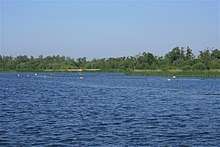Ant Broads and Marshes
Ant Broads and Marshes is a 745.3-hectare (1,842-acre) biological Site of Special Scientific Interest north-east of Norwich in Norfolk.[1][2] Most of the it is a Nature Conservation Review site, Grade 1,[3] and it is part of the Broadland Ramsar[4] and Special Protection Area,[5] and The Broads Special Area of Conservation.[6] Part of it is the Barton Broad nature reserve, which is managed by the Norfolk Wildlife Trust,[7] and two areas are National Nature Reserves.[8][9]
| Site of Special Scientific Interest | |
 Barton Broad | |
| Area of Search | Norfolk |
|---|---|
| Grid reference | TG 365 215[1] |
| Interest | Biological |
| Area | 745.3 hectares (1,842 acres)[1] |
| Notification | 1989[1] |
| Location map | Magic Map |
This site in the valley of the River Ant is described by Natural England as "finest example of unpolluted valley fen in Western Europe". It has a network of dykes which support a diverse variety of aquatic plants, and its fenland invertebrate fauna is of national importance.[10]
References
- "Designated Sites View: Ant Broads and Marshes". Sites of Special Scientific Interest. Natural England. Retrieved 6 June 2018.
- "Map of Ant Broads and Marshes". Sites of Special Scientific Interest. Natural England. Retrieved 6 June 2018.
- Ratcliffe, Derek, ed. (1977). A Nature Conservation Review. 2. Cambridge, UK: Cambridge University Press. pp. 214, 307. ISBN 0-521-21403-3.
- "Designated Sites View: Broadland". Ramsar Site. Natural England. Retrieved 25 May 2018.
- "Designated Sites View: Broadland". Special Protection Area. Natural England. Retrieved 25 May 2018.
- "Designated Sites View: The Broads". Special Area of Conservation. Natural England. Retrieved 25 May 2018.
- "Barton Broad". Norfolk Wildlife Trust. Retrieved 21 May 2018.
- "Designated Sites View: Ant Broads and Marshes". National Nature Reserves. Natural England. Retrieved 25 May 2018.
- "Designated Sites View: How Hill". National Nature Reserves. Natural England. Retrieved 5 June 2018.
- "Ant Broads and Marshes citation" (PDF). Sites of Special Scientific Interest. Natural England. Retrieved 6 June 2018.
| Wikimedia Commons has media related to Ant Broads and Marshes. |